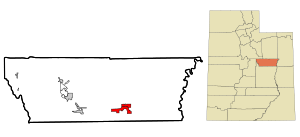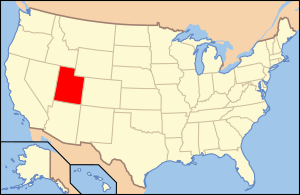East Carbon, Utah facts for kids
Quick facts for kids
East Carbon, Utah
|
|
|---|---|
|
Former city
|
|

Location in Carbon County and the state of Utah.
|
|

Location of Utah in the United States Coal Coal Coal
|
|
| Country | |
| State | |
| County | Carbon |
| Incorporated | July 23, 1973 |
| Merged with Sunnyside | January 1, 2014 |
| Area | |
| • Total | 11.30 sq mi (29.26 km2) |
| • Land | 11.29 sq mi (29.25 km2) |
| • Water | 0.01 sq mi (0.02 km2) |
| Elevation | 5,987 ft (1,825 m) |
| Population
(2020)
|
|
| • Total | 1,556 |
| • Density | 140.26/sq mi (54.16/km2) |
| Time zone | UTC-7 (Mountain (MST)) |
| • Summer (DST) | UTC-6 (MDT) |
| ZIP code |
84520
|
| Area code(s) | 435 |
| FIPS code | 49-20890 |
| GNIS feature ID | 2410386 |
| Website | www.eastcarboncity.org |
East Carbon was a city in Carbon County, Utah, in the United States. It was formed on July 23, 1973, when two older mining towns, Dragerton and Columbia, joined together. Later, on January 1, 2014, East Carbon merged with the nearby city of Sunnyside. This new city was first called East Carbon-Sunnyside, but its name was later changed back to East Carbon City. At the 2020 census, about 1,556 people lived there.
Contents
Where Was East Carbon Located?
East Carbon was found in the southeastern part of Carbon County. It was about 23 miles (37 km) east of Price, which is the main city and county seat.
The city covered a total area of about 11.3 square miles (29.26 square kilometers). Most of this area was land, with only a very small part being water.
How Many People Lived in East Carbon?
The number of people living in East Carbon changed over the years. Here's a quick look at its population:
| Historical population | |||
|---|---|---|---|
| Census | Pop. | %± | |
| 1980 | 1,942 | — | |
| 1990 | 1,270 | −34.6% | |
| 2000 | 1,393 | 9.7% | |
| 2010 | 1,301 | −6.6% | |
| 2020 | 1,556 | 19.6% | |
In 2000, there were 1,393 people living in East Carbon. About 29.4% of the homes had children under 18. The average age of people living there was 41 years old.
The Story of East Carbon: From Mining Towns to One City
East Carbon City has an interesting history that began with coal mining.
The Beginning: Dragerton
The town of East Carbon started in the fall of 1942. The U.S. government needed more coal during World War II. So, they decided to build a new town to house coal miners and their families. These miners worked in the mines that supplied coal to the Geneva Steel mill.
The town was first named "Drager" after W.L. Drager, an engineer who helped plan it. However, the Post Office Department said the name was too similar to another Utah town, Draper. This could cause confusion with mail delivery. So, the citizens chose a new name: "Dragerton."
In 1947, the Geneva Steel Company bought Dragerton. It became a "company town," meaning the company owned most of the homes and services. There were 605 modern buildings in the town at that time.
The Name Change and High School
In 1959, when many people lived in the area, a new high school was built. It was placed on land between Dragerton and Sunnyside, donated by a local mining company called Kaiser Steel. Students voted to name it East Carbon High School, and their mascot became the Viking.
When Dragerton officially became a city in 1973, its name was changed to "East Carbon City." This matched the name of the high school.
The high school closed in 2005. A new school, Bruin Point Elementary School, was built the next year. It is now the only school serving the East Carbon area.
Columbia's Role
When East Carbon was formed in 1973, the nearby town of Columbia also became part of the new city. Columbia is about 4 miles (6.4 km) southeast of the main East Carbon area. Even though they merged, many people in the area still call that part "Columbia."
See also
 In Spanish: East Carbon (Utah) para niños
In Spanish: East Carbon (Utah) para niños

